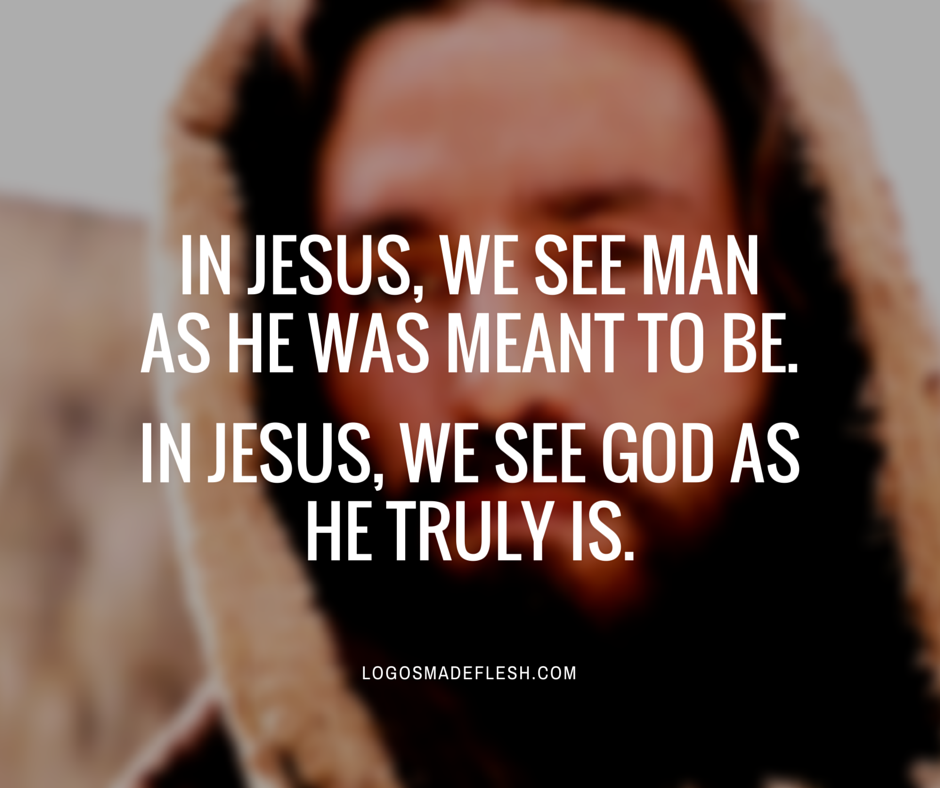Archives For Theology
Over the years I’ve encountered many Christians concerned with symbolism in the Gospel of John. They’re particularly troubled with the notion that John intended objects and images to convey a coded meaning. They might be bothered for instance that
- the “water jar” in John 4:28-29 points to the woman’s abandonment of tradition
- the “night” in John 3:1 and 13:30 refers to more than just time of day.
- the parenthetical naming of the servant in John 18:10 is included because it means kingdom.
- Or that the water which flows from Jesus’ side in John 19:34 represents the Holy Spirit.
And they, of course, have reasons for their concern. Two come to mind.
(1) Symbols seem the product of an overly imaginative author tampering with historical fact. Like a story with too many coincidences, symbols rub at our confidence in an eyewitness report. We expect witnesses to give fresh, trivial details of what they’ve seen and heard. But the presence of meaningful objects point to a premeditated creativity. Where might history end and the authors imagination begin?
(2) Symbolic interpretations appear to bypass the plain meaning of the text. Good interpretation must be grounded in rules which cause readers of varying backgrounds to arrive at similar conclusions. Since the “discovery” of symbols has all too often varied from one interpreter to the next, they appear to arise from an “interpreter’s” whim and not the text itself.
Bottom line: symbols hijack history and or the author’s true intent.
I think we should heed these cautions. The way a symbolic reading is presented can indeed lead some to question the gospel’s veracity. Likewise without proper criteria the claim of symbolism is open to abuse. But while we should heed these cautions it doesn’t mean we must discount John’s or the Bible’s use of symbolism. Symbols are not antithetical to history nor is the discovery of deeper meaning damned to be divorced from proper interpretive criteria. Symbols can and often are faithful to the facts.
Symbolism in History
History is full of legitimate symbols. For example, we know Abraham Lincoln was assassinated on Good Friday 1865 just five days after Palm Sunday’s official end to the Civil War. Lincoln’s final week thus corresponds significantly to Jesus’ final week. Jesus entered triumphantly into Jerusalem on Palm Sunday and on that first Good Friday he’s executed on the cross. But the correspondences do not end there. Like Jesus’s life and death, which brought spiritual freedom to humanity, Lincoln’s leadership and untimely death resulted in a “new birth of freedom” for the slaves. That authors have seen in these remarkable similarities Lincoln as a type or symbol of Christ by no means undermines their historic credibility.
Craig Koester states,
“We can discern symbolic significance in images, events, or persons without undercutting their claims to historicity, and we can recognize that certain images, events, and people are historical without diminishing their symbolic value.”
According to Xavier Leon-Dufour, Symbolism
“should be understood as putting together the surface and deeper realities rather than as evacuating the surface of the text simply to reach the deeper reality.”
Even St. Augustine saw no tension between the historical facts of John’s Gospel and the deep creativity involved in producing it. He says John,
‘is like one who has drunk in the secret of His divinity more richly and somehow more familiarly than others, as if he drew it from the very bosom of his Lord on which it was his wont to recline when He sat at meat’
The presence of symbolism in John does not mean he was an overly imaginative author. It means he reflected deeply on the significance of the events. John can faithfully record history while highlighting its profound connections and meaning.
Interpreting Symbols
Literature, both ancient and modern, is full of real and yet implicit symbols. We know that authors use symbols. But we also know not everything that is claimed as symbol is truly symbolic. So how do interpreters know which is which?
In How to Detect a Symbol, I described two ways of knowing. First, by an initiation into the author and audiences shared knowledge and experience. Like an inside joke, the author winks and the reader smiles while the uninitiated might simply be told, “just had to be there.” And secondly by the author defining the meaning of symbol within the text itself. If an author feels his audience may not readily understand his meaning, he or she will supply a definition for their audience.
In principle, people recognize the accuracy of these two criteria. It’s the extent to which they’re used which bothers some. Most, for instance, are not troubled by an author giving a word or an object an alternative meaning if and when they do so directly (i.e. x = 2). It’s troubling, however, when it’s too subtle, when we can’t connect the dots. Without a carefully considered argument, the claim of symbolism can appear as perplexing as a magician pulling a rabbit out of a hat. But such tricks aren’t real magic, rather they’re a carefully crafted illusion arising from a systematic process. It appears bewildering only because we don’t know how it works.
It takes more than an interpreter declaring, “this means X” for an object to be a symbol. To a person bypassing a careful engagement with the text we would rightly respond, “that’s just your interpretation.” A true interpretation is a matter of carefully laying out the narrative evidence.
Authors can define symbols overtly (i.e. x = 2) but they can also do so covertly through such things as parallels in character’s speech or comparisons in narrative structure. We need to recognize, unlike the world in which we live, there is no real division in a story between a character’s words and those of events, objects and images. All have been carefully shaped and edited by an author. If a narrator or a character makes a meaningful comparison to an image in a figure of speech or the author invites comparison in the sandwiching of different scenes it opens up the the possibility that such object and images are used symbolically when they appear physically elsewhere within the the world of the story.
Its helpful to think of objects and images like words. A single world, like “hand” for instance, can have a verity of definitions which only become apparent in context
- the hired hand fixed the railing
- his hand was illegible
- he wanted to try his hand at singing
- on the one hand…, but on the other…
- I didn’t hold a good hand all evening
- The hands read 3:25
- give the little lady a great big hand
- hand me the spoon, please
- hand the elderly lady into the taxi
Such a list of uses for a single word come ready made in our culture. But authors can also add their own uses to this list. The same is true for the meaning of objects and images. The metaphorical or symbolic meaning becomes one possible meaning which context alone helps us determine. Just because Jesus calls himself the light of the world in one sermon does not mean that light is symbolic of Jesus everywhere it occurs. But possibility becomes probability when a symbolic meaning is found to cohere in the images immediate context. So if Jesus defines himself as the light in a specific sermon, then related images of darkness within the story can given a specific context take on an opposing significance.
Perhaps I should end with a parting example.
In John 18:36 Jesus declares,
“My kingdom is not of this world. If My kingdom were of this world, then My servants would be fighting so that I would not be handed over to the Jews; but as it is, My kingdom is not of this realm.”
There is a glaring discrepancy in Jesus’ statement. Peter had just been fighting to stop Jesus’ arrest. He drew a sword and severed a man’s ear (18:10).
It’s interesting to note that while Matthew and Mark record this earlier incident, only John names Peter as the one who attacked the man and, in a concluding parenthetical statement, Malchus as the one whom he attacked. Is the identification of Peter and Malchus simply the fresh, trivial detail of an eyewitness? Or does John find the significance in the fact that Malchus‘ name in Aramaic truly means kingdom? Jesus statement about fighting and His kingdom certainly drives our attention back to this scene and causes us to look at it again with fresh eyes. It seems to me highly likely, given Jesus later statement and its apparent connection to Peter’s fighting, that John included this historic detail, not just because it was historically true but because it symbolically revealed something significant in Peter’s actions.
A symbol is a physical representation of an intangible idea. Authors, both ancient and modern, use symbols to convey abstract meaning. The problem with symbols, however, is that they often appear as part of an implicit dialogue between author and audience. It’s thus possible to misread an image as a symbol or a symbol as simply an image. So how do we know when an image or object within a story is more than just that? How do we know when its meant to convey something deeper?
If an author intends an object or image to be symbolic he or she must either rely upon a community’s preexisting symbolic language or make an effort to define the symbolic meaning of the image within the text itself. Ruben Zimmermann in his book Imagery in the Gospel of John thus offers two criteria for weighing a symbols plausibility: (1) conventional plausibility and (2) textual plausibility. He returns to these two criteria in Anatomies of Narrative Criticism
With regard to the criterion of convention plausibility, if a motif such as “light,” “shepherd,” and the like holds a great deal of religious meaning within a linguistic community due to a Bildfeldtradition(traditional semantic field) that can be substantiated by means of older and contemporary texts, then there exists a high level of plausibility that the motif is being used symbolically, in line with conventional usage. Here we may speak of evidence of plausibility outside the text. The criterion of textual plausibility would hold that the way in which an author identifies a motif within a text as a symbol will be made clear by clues in the text. Thus I would speak here of evidence for plausibility within the text. The symbolism of a text can be identified from the specific interaction between social-traditional convention and the actual textual-evidence.
Conventional Plausibility
When an author assumes his audience will recognize his meaning he or she draws a curtain between his group and those outside his community. The only way for outsiders to peek behind this curtain is to acquaint themselves with the common sources from which the author and his community derived its symbols. For instance, the gospel of John’s symbolic language like the Greek language John speaks arises in part from his social setting. Giving heed to the material that evidently played a part in his writing can supply ample information for symbolic investigation. Thankfully, with regards to the religious books of the Bible, their sacred texts are by and large still with us today. The plausibility of a proposed symbol is thus first weighed by its continuity with known scriptural convention.
Textual Plausibility
But authors also take care to define their symbols within the text. This occurs in at least two ways. First the author can use the narrator or characters within the story to make an explicit connection or comparison between two unlike things. A good modern example of how this shift takes place can be found in the movie The Shawshank Redemption. Notice how Andy links music to hope and Red more specifically to a harmonica.
ANDY: (taps his heart, his head) The music was here…and here. That’s the one thing they can’t confiscate, not ever. That’s the beauty of it. Haven’t you ever felt that way about music, Red?
RED: Played a mean harmonica as a younger man. Lost my taste for it. Didn’t make much sense in here.
ANDY: Here’s where it makes most sense. We need it so we don’t forget.
RED: Forget?
ANDY: That there are things in this world not carved out of gray stone. That there’s a place inside of us they can never lock away, and that place is called hope.
Later in the film the mere image of a harmonica becomes a symbol by invoking the metaphor of the previous conversation. Andy gives Red a harmonica as a “parole rejection” present. When asked if he’s going to play it, Red responds, “no, not right now.” The gift has moved beyond a mere object and now points to the hope which Andy provides and Red doesn’t want to let in.
In John’s gospel the symbols most easily recognizable are those found first in metaphor. “I am the light of the world” Jesus says. The incongruity of Jesus speaking of one thing in terms of another pushes the reader passed a literal meaning to reconcile meaning abstractly. Metaphors clearly denote John’s core symbols, images that occur frequently and contribute most to the gospel’s message. For instance Christ’s claim to be “the light of the world” establishes light as a symbol. Its frequency and placement underscore its vital importance (1:9; 3:19; 8:12; 9:5; 12:46).
A second way an author can define a symbol is through narrative structure. For instance, Mark, the earliest of the four New Testament gospels, records the following scenes in this order.
- Jesus looks for fruit on a fig tree but finding none curses it (11:12-14
- Jesus enters Jerusalem and attacks the temple (11:15-19)
- The disciples see the fig tree withered from the root and ask Jesus about it (11:20-25)
The sandwiching of these stories indicates that the fig tree is a symbol of the temple. The cursing of the fig tree and its subsequent withering represents Jesus attack on the temple and its subsequent destruction. Jesus’ later teaching on the mount of Olives (Matthew 24, Mark 13, Luke 21) has this meaning in mind. Here, Jesus appeals to the meaning of the fig tree.
Now learn this lesson from the fig tree: As soon as its twigs get tender and its leaves come out, you know that summer is near. Even so, when you see these things happening, you know that it is near, right at the door. I tell you the truth, this generation will not pass away until all these things have happened. Heaven and earth, will pass away, but my words will never pass away.
One further thought. The symbols arising from the original metaphor or structural association need not be restricted to their specific language. For instance if Red had never made the explicit connection between music and a harmonica the harmonica still would have been a plausible symbol for hope in the proceeding scene. That’s because a harmonica is a subset of the larger concept of music. For example, later in the Shawshank Redemption, we find Heywood listening to Hank William’s records in the Library Andy has built. While Hank Williams has not been explicitly connected to the metaphor his music falls under the same category.
This occurs repeatedly in John’s gospel. Beyond metaphors to light we find linked references to things like darkness, day, night, blindness, and sight. The conceptual link to a central symbolic image suggests that these images likewise are to be understood symbolically. Philip Wheelwright has observed that many symbols have “a bright focused center of meaning together with a penumbra of vagueness that is intrinsically ineradicable.” The core symbol established in metaphor and clearly defined in context acts as the “bright focused center” while the linked images appear to radiate out in more or less decreasing precision.
Some of these images are more transparently symbolic than others. For instance, when the statement “men loved darkness rather than light” appears at the end of Jesus’ dialogue with Nicodemus it suggests that Nicodemus’ approach by “night,” is more than simply setting. Likewise the regular reoccurrence of light in John indicates a similar symbolic sense for Judas’ final departure (13:30) though only “night” is mentioned in the immediate context.
Of course not all images related to a core symbol have this probability. Craig Koester states,
When attempting to identify elements that may function symbolically as part of a motif, we do well to say that some are almost certainly symbolic and that others are only possibly symbolic.
Frequency and or context are once again the clearest guides to establishing likelihood. For instance, John’s light motif may play an ironic role in the solder’s use of lanterns and torches to arrest Jesus, “the light of the world.” However, because lanterns and torches are not mentioned or connected elsewhere in John with the light motif, the probability of an intended symbol, though good, is not as great.
The world breaks down into two types of people, those who see signs and those who see chance.
So says Mel Gibson’s character in M Night Shyamalan’s hit movie Signs. If you’ve ever seen a film written and directed by M Night Shyamalan, you’ll know exactly what he means. Shyamalan’s films often hinge on two ways of seeing.

The Sixth Sense
In the Sixth Sense, Night takes his audience through the experience of Malcolm, a child psychologist, who needs to regain his professional confidence after being shot early in the film by an enraged former patient.
Malcolm spends the rest of the film working with the shy and reluctant Cole Sear, a child showing many of the same strange symptoms that plagued his assailant. As the film progresses Cole opens up to Malcolm more and more.
Half way, Cole confesses to his counselor that he’s afraid because he see’s dead people, walking around as if they were alive all the while not knowing they are dead. Malcolm believes Cole and helps him come to grips with this gift.
The real bombshell, however, occurs in a closing scene when Malcolm, along with the audience, discovers that he himself is one of those dead people who sought his patients help. In His moment of realization the film quickly recaps half dozen scenes in which you can see how each has been wrongly perceived. Although it appears that Malcolm has spoken to others in the film, in reality no one has spoken to him since his shooting except the young boy.
Watching the movie a second time reveals how each action in the movie is ambiguous, encouraging the audience to mistakenly grasp the significance of the story until the very end.
Signs
In Signs, Shyamalan again builds into his story this two-sided perspective. The title itself participates in the film’s double meaning.
At a first glance, Signs refers to the crops circles and other mysterious appearances that provoke the small family, around which the film centers, to believe they are being visited by aliens. Yet, as the movie progresses we find that while this may be the external situation around which the plot develops, the movie is really about Grant, the father of the family, and his loss of faith in the absence of God given signs.
Like each scene in the Sixth Sense, the title is ambiguous. Although the audience doesn’t see it at first, Grant’s statement that, the world breaks down into two types of people those who signs and those who see chance” mirrors Cole’s confession to Malcolm. It is the statement upon which the film will hinge.
Just like the title, evidence for God’s presence is often itself ambiguous. In the end, Shyamalan reveals in the ordered assembly of the numerous quirks in the story, the young daughter’s inability to finish a glass of water, the son’s asthma and the brothers desire to swing a bat a benevolent God.
Although God is never seen in the film, the order in the films closing reveals that he is in fact present to those who have eyes to see.
The Village
The Village, while not as popular as the Sixth Sense or Signs, still trades on the concept of sight.
The film centers on a group of families living in small colonial community and in particular two youths a quite boy and Ivy, a girl who is out going but blind. Throughout the film, the town is dominated by the fear of a wild beast – he who must not be named – that roams the forest, keeping the villagers confined to their tiny world. But when the quiet boy is wounded, the blind girl must confront the forest and seek help from the outside.
Remarkably it is she who is blind who is shown that the beast is simply a costume, a phantom created by the elders to keep the young from leaving the village.
After groping through the forest she climbs a fence to the other side. In that moment the film cuts to Ivy’s parents back in the village. They open a box and pull out some papers and old photographs. The photographs reveal a past that is not a sepia toned pioneer world; instead it’s a colored photo of the 1960’s. The audience at once experiences a paradigm shift. In an instant, past and present slam together. The village does not exist in the past, rather it is a gated community locked away from the present.
Cutting back to Ivy on the other side of the fence, we find her confronted not by a horse and buggy but a modern SUV. In Shyamalan’s worldview the blind are the ones who are truly able to see. For unlike the audience, there blindness has allowed them not to be fooled by the external trappings of this world.
It is Shyamalan’s penchant for dazzling his audiences with things hidden in plan sight which has made his films so successful. The movies in and of themselves reveal that there are truly two types of people, those that see and those that don’t. At first the audience is completely blind, ignorant of even of their own ignorance, unable to even comprehend that they are interpreting the story wrong. When the revelation comes however it not only exposes their ignorance but gives them eyes to see.
Because his audiences have come to expect these twist ending,Shyamalan has shied away from making such films in recent years. It’s made the game of the screenwriter increasingly more difficult. But It should come as no surprise to learn that Shyamalan has named his production company Blinding Edge Pictures.
Many scholars today believe the Gospel of Luke offers no theology of substitutionary atonement. In other words they hold that Luke does not present Jesus’ death as doing for us what we could not do for ourselves. Greg Herrick states,
The reason for the scholarly movement away from a vicarious interpretation of the death of Christ in Luke-Acts is due to the fact that apart from two passages Luke never appears to make that equation. That is, apart from these two passages, he never explicitly links the death of Christ with forgiveness of sins. The problem is further compounded by the fact that the two passages in question, namely, Luke 22:19-20 and Acts 20:28 are fraught with both textual and interpretive problems.
It’s not my intention to rehash all the issues here. You can find excellent overviews here and here. Instead I want to offer an entirely overlooked way through the haze. It’s my contention that Luke does present Jesus and his death as overturning the curse placed upon us due to Adam’s sin. Luke does this by depicting Jesus as a new victorious Adam.
1. Luke presents Jesus as a new Adam.
This is beyond a doubt Luke’s purpose in the placement and arrangement of Jesus’ genealogy. Unlike Matthew who places his genealogy at the outset of his gospel, Luke places it immedietly after Jesus’ adult baptism and just prior to the temptations. It’s thus bookend by the issue of Jesus’ sonship. In the baptism God declares Jesus to be His “beloved Son” and in the temptations Satan challenges Jesus on precisely this point. “if you are the Son of God…”
Also instead of beginning with Abraham and working forward to Jesus, as Matthew does (Matthew 1:1-16), Luke genealogy begins with Jesus and works backwards to Adam (Luke 3:23-38). The net effect makes his genealogy a list of sons rather than a list of fathers and points to Adam rather than Jesus. Of course Luke’s intention is not to diminish Jesus but rather, in light of the context, to make a comparison between Jesus and Adam. Both are said to be God’s son.

2. Luke presents Jesus as tempted like Adam.
Jesus’ three temptation follow immediately after the genealogy. If Luke intends to present Jesus like Adam than the temptations could not have been better placed. But Jesus’ success here is merely the beginning of a battle that will continue in the later part of Luke. Luke tells us that after the temptations the devil, “left him until an “opportune time” (4:13). In Luke, Satan finds this opportunity at the beginning of the crucifixion plot, entering into Judas Iscariot (Luke 22:3).
This suggests that the events surrounding the crucifixion are themselves a continuation of the temptation. Certainly there are echoes of the devil’s challenge at the trial when the leaders ask, “Are you the Son of God…” (22:70). And it’s Jesus’ bold “Yes!” which seals his fate and overcomes the desire to save his own skin.
As with the other gospels Jesus confession is juxtaposed with Peter’s denial. If Peter’s denial is due to, as Luke tells us, the sifting of Satan (22:31-32) then there is little doubt Satan is also present in this challenging question to Jesus. It echoes the devil’s challenge in the earlier temptations.
3. Luke presents Jesus undoing the curse of Adam.
At Jesus’ death, the centurion declares, “surely this man was innocent!” Here Luke differs remarkably from the centurion’s confession in the gospels of Matthew and Mark. In those accounts the centurion says, “Truly this man was the Son of God!” Owing to the fact that Luke has already declared Jesus to be the Son of God, it is doubtful that Luke wants to downplay this fact here. Instead it appears the verdict of innocence is in some sense connected to Jesus being like Adam, the Son of God.
For Luke, Jesus’ innocence is not simply in reference to the crime for which He has been charged but His victory over all temptation. What Christ has done in his persistent innocence is to reopen the way closed by Adam. Jesus final words to the thief on the cross are directly connected to this second Adam motif, “Truly, I say to you, today you will be with me in Paradise.” “Paradise” is the same Greek word used elsewhere in Septuagint and the book of Revelation for the “garden” of Eden.
Several of these points have been noted by others (here and here) but as of yet I have found no one who sees in Luke’s Adam the key to Luke’s theology of vicarious atonement. Does Luke teach that the crucifixion of Jesus satisfies God’s punishment for sin? Absolutely. Jesus is the victorious Son of God who’s final victory over temptation reverses the curse of Adam.


























